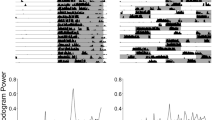Abstract
Using real-time gene expression imaging and behavioral analysis, we found that the perinatal photoperiod has lasting effects on the circadian rhythms expressed by clock neurons as well as on mouse behavior, and sets the responsiveness of the biological clock to subsequent changes in photoperiod. These developmental gene × environment interactions tune circadian clock responses to subsequent seasonal photoperiods and may contribute to the influence of season on neurobehavioral disorders in humans.
This is a preview of subscription content, access via your institution
Access options
Subscribe to this journal
Receive 12 print issues and online access
$209.00 per year
only $17.42 per issue
Buy this article
- Purchase on Springer Link
- Instant access to full article PDF
Prices may be subject to local taxes which are calculated during checkout


Similar content being viewed by others
References
Ohta, H. et al. Pediatr. Res. 60, 304–308 (2006).
LeVay, S. et al. J. Comp. Neurol. 191, 1–51 (1980).
Dulcis, D. & Spitzer, N.C. Nature 456, 195–201 (2008).
Wiesel, T.N. & Hubel, D.H. J. Neurophysiol. 26, 978–993 (1963).
Wiesel, T.N. & Hubel, D.H. J. Neurophysiol. 26, 1003–1017 (1963).
Foster, R.G. & Roenneberg, T. Curr. Biol. 18, R784–R794 (2008).
Ciarleglio, C.M. et al. J. Neurosci. 29, 1670–1676 (2009).
Inagaki, N. et al. Proc. Natl. Acad. Sci. USA 104, 7664–7669 (2007).
VanderLeest, H.T. et al. Curr. Biol. 17, 468–473 (2007).
Naito, E. et al. J. Biol. Rhythms 23, 140–149 (2008).
Meng, Q.J. et al. Neuron 58, 78–88 (2008).
Ishida, Y. et al. J. Neurosci. Res. 64, 612–616 (2001).
Barrett, R.K. & Page, T.L. J. Comp. Physiol. A 165, 41–49 (1989).
Pyter, L.M. & Nelson, R.J. Behav. Neurosci. 120, 125–134 (2006).
Wehr, T.A. et al. Arch. Gen. Psychiatry 58, 1108–1114 (2001).
Acknowledgements
The authors would like to thank J.Y. Cohen for kindly providing custom software programming. This work was supported by US National Institutes of Health grants P50 MH078028 (D.G.M.), T32 MH64913 and F31 MH080547 (C.M.C.).
Author information
Authors and Affiliations
Contributions
C.M.C. and D.G.M. designed the experiments. C.M.C., J.C.A. and B.R.S. performed the experiments and compiled the results. C.M.C. and K.L.G. performed statistical analyses. C.M.C. and D.G.M. wrote the paper.
Corresponding author
Ethics declarations
Competing interests
The authors declare no competing financial interests.
Supplementary information
Supplementary Text and Figures
Supplementary Figures 1 and 2, Supplementary Tables 1–3, Supplementary Methods and Supplementary Results (PDF 427 kb)
Rights and permissions
About this article
Cite this article
Ciarleglio, C., Axley, J., Strauss, B. et al. Perinatal photoperiod imprints the circadian clock. Nat Neurosci 14, 25–27 (2011). https://doi.org/10.1038/nn.2699
Received:
Accepted:
Published:
Issue Date:
DOI: https://doi.org/10.1038/nn.2699
This article is cited by
-
Development of the circadian system in early life: maternal and environmental factors
Journal of Physiological Anthropology (2022)
-
Early life circadian rhythm disruption in mice alters brain and behavior in adulthood
Scientific Reports (2022)
-
Photoperiodic effects on monoamine signaling and gene expression throughout development in the serotonin and dopamine systems
Scientific Reports (2020)
-
Short-active photoperiod gestation induces psychiatry-relevant behavior in healthy mice but a resiliency to such effects are seen in mice with reduced dopamine transporter expression
Scientific Reports (2020)
-
The role of the circadian system in the etiology and pathophysiology of ADHD: time to redefine ADHD?
ADHD Attention Deficit and Hyperactivity Disorders (2019)



